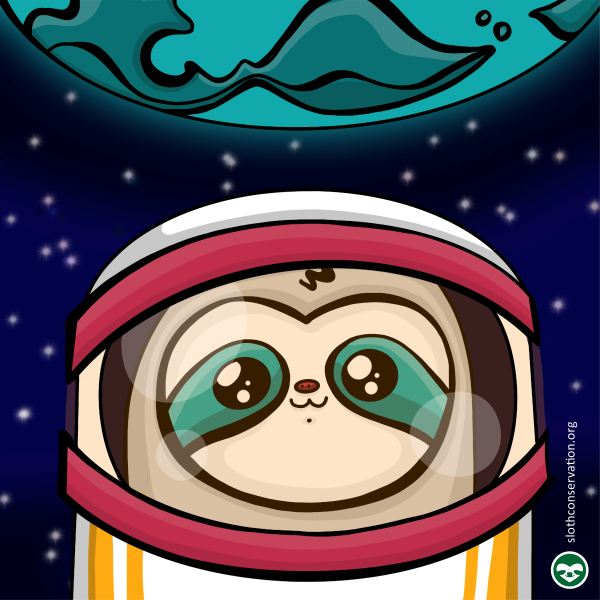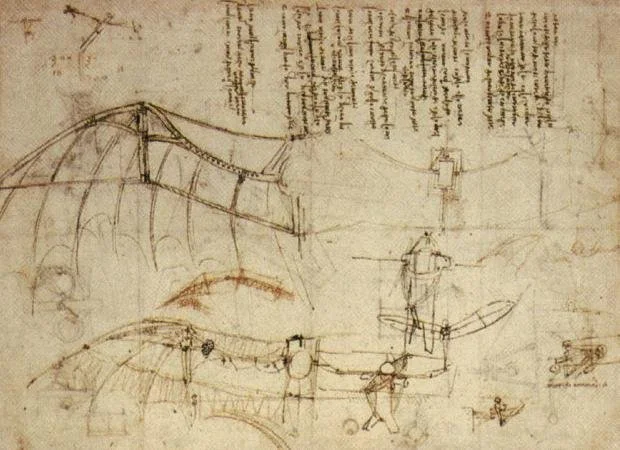Sloths in Space: Celebrating Human Spaceflight with a Theoretical Twist from the Treetops
To celebrate the International Day of Human Spaceflight, held every April 12th, we're reaching for the stars with a little help from one of our most stellar supporters: Ponder E. Stine.
Not only is Ponder one of our biggest advocates, but he also happens to be a professional aerospace engineer with a background in human spaceflight and bioastronautics (the study and support of life in space)!
Having studied aerospace engineering and computer science at the University of Colorado Boulder, Ponder is currently working as a professional software engineer at Amazon on an incredible satellite internet program called Project Kuiper, and he brings his love for spaceflight and nature together in ways that spark our imagination.
So while most of us are still Earth-bound (including our sloths and Ponder), today we celebrate how far humanity has come, and take this opportunity to imagine what might happen if a sloth ever found itself in zero gravity.
Early spaceflight: Pups and Primates Before ‘Peter’s and ‘Paul’s
There is a long and storied history of sending life into the hostile and unforgiving environment of space. Before anyone had actually been to space, nobody knew what the consequences of spaceflight would be on the human body. Some experts even worried about situations that sound outlandish with what we know today - for example, many thought that humans would be unable to avoid swallowing their own tongues and choking on them in the weightless environment of space. Because of this, humans were not the initial “test dummies” for more than a decade of early rocketry, spaceflight, and bioastronautics.
The first living creatures to be put on a rocket and sent to space (defined as being above the internationally-recognized Karman line at ~100 km altitude above sea level) were actually fruit flies! In February of 1947, an American V2 sub-orbital rocket launched from White Sands, New Mexico - and the fruit flies (Drosophila melanogaster) were successfully recovered alive after landing back on the ground under parachute.
It wasn’t until 1949 when Albert II, an American Rhesus monkey, flew to a peak altitude of 134 km, becoming the first mammal in space. Albert II did survive the brief exposure to weightlessness, but unfortunately perished when his capsule crashed to Earth after a parachute failure (the 1940s and 50s were packed with failed or partially-failed space missions).
In the early 1950s, the Soviet space program began using mice, rats, and rabbits as test subjects, often anesthetized and covered with sensors measuring vital signs and other markers of life. Many of these early Soviet missions were intentionally designed to be ‘one-way’, and the ethical implications of using animals as expendable, living test subjects will forever be stitched into the history of rocketry and the journey to space.
In July 1951, the Soviets launched the first two canines to space. The pups named Dezik and Tsygan were the first “living higher organisms” to be successfully recovered alive after their suborbital spaceflight.
Dezik and Tsygan
In November 1957, the second-ever rocket launch to reach a stable Earth orbit carried the famous Laika, a stray dog from Moscow who became the first living organism to orbit the Earth.
Laika by unknown – Soviet space program employee / Wikipedia
Nearly a dozen canines were launched by the Soviet space agency in the decade between the first sub-orbital flight of canines Dezik and Tsygan and the first suborbital flight of a human when cosmonaut Yuri Gagarin became the first human to reach space in 1961.
1964 Soviet postage stamp honoring Gagarin’s journey.
Throughout the 1960s, many more animals, including new species, were sent to space for research purposes. In 1968, the Zond5 mission sent the first living creature(s) to visit the moon; two tortoises (accompanied by some wine flies and mealworms) went on a circumlunar voyage months before any Apollo astronauts traveled to the moon. The Zond5 tortoises thankfully survived their epic journey.
Animals continue to be used as spaceflight test subjects by many countries’ space agencies and private companies, pushing the boundaries of what is known and what is possible.
Could Sloths Survive in Space?
It might sound like science fiction, but sloths have some fascinating physical adaptations that could theoretically make them decent space travelers (if only in imagination). Their famously slow metabolism, low-energy lifestyle, and efficient use of oxygen could actually be advantageous in low-resource environments like space!
One of the hardest challenges for sending humans to space is sending all of the “consumable” supplies along to keep them alive (just like camping, modern spaceflight requires bringing everything with you for the whole journey). The main consumables that add to the cost, complexity, and risk of spaceflight are oxygen, heat, water, and food (almost always in that order).
The significantly lower metabolic rate of sloths can greatly simplify the requirements for how much oxygen, food, water, and energy would be required to keep a sloth-stronaut alive compared to keeping a human astronaut alive (relative to body mass and over the same mission/duration).
Sloths eat just a handful of leaves a day!
And let’s not forget: sloths are masters of calm. Their serene demeanor and lack of sudden movements would probably make them less prone to the stress and disorientation that can affect humans during spaceflight.
Living Upside-Down vs. Living in Zero Gravity
Life on Earth did not evolve for the hostile environment of space, but sloths’ natural ability to stabilize their organs might offer some biological insight into long-term space travel and how to support human anatomy in zero gravity.
Holding the organs in position
One particularly cool sloth adaptation is the presence of fibrous adhesions that keep their internal organs in place.
Hoffmann’s Two-fingered Sloth (Choloepus hoffmanni) | Suzi Eszterhas
These adhesions prevent the stomach from crushing the lungs, something that would otherwise be a big problem when you're upside down all day! These same adaptations for a life lived upside down could prove very useful for sloth health and well-being in space.
Space muscles
A major aspect of spaceflight that is hard on the body is the lack of stressors to promote bone and muscle growth - even sitting upright on Earth requires the structural support of your bones and muscles to keep things in line. In space, you don’t need to fight the force of gravity since very small pushes and movements can get you moving where you want to go.
Because of this, the human body significantly atrophies (loses) bone and muscle mass when in space - astronauts on the International Space Station (ISS) spend around 2 hours every day exercising on specialized treadmills and weightlifting equipment to combat the muscular and skeletal atrophy they otherwise would face (the machines resist the force of magnets and hydraulics instead of resisting the force of gravity acting upon a heavy weight).
Sloth anatomy has already been optimized greatly through natural evolution and millions of years of trial. For sloths to have such a low metabolism, they need to have only the necessary amount of bone and muscle mass. Sloths would start their journey with less excess muscle and bone to atrophy in space, and this could lead to a significantly harder and/or longer recovery process after returning back to Earth - it is also certainly possible that they have accidentally found the “sweet spot” of body mass for spaceflight and would not face atrophy similar to humans.
Sloths don't rely on gravity to help blood flow
When weightless in space (sometimes called “Zero-G” or “microgravity”), our bodies go through radical shifts. On Earth at “1 G” (normal gravity as you are likely experiencing right now), an organism’s body needs to work harder to pump blood and fluids up to the head than pumping down to the lower extremities - astronauts in space don’t have gravity pulling on them in the same way, and so fluids redistribute (similar to when you hang upside down and the blood/fluids rush to your face).
This leads to a condition called “puffy face, bird leg” syndrome - the human body’s natural design to pump more fluid toward the head and upper body no longer helps out in space when there isn’t significant gravity to push against, and so more fluid stays “up” around the head (this is thought to be a leading cause of Spaceflight-Associated Neuro-Ocular Syndrome (SANS), leading to greatly degraded vision and sight while in space).
Sloths spend most of their lives hanging upside down, and their bodies have evolved in amazing ways to support this. Sloths have remarkably low blood pressure and slow heart rates, both of which are part of their energy-conserving lifestyle. Their circulatory system is adapted to support their upside-down existence, with efficient blood flow and minimal strain on the heart despite gravity acting in the reverse direction.
Two-fingered sloth using the bridge installed over a main road.
In space where blood tends to shift toward the upper body and head (and gravity isn’t pulling significantly on fluids in any direction), sloths might actually have an advantage compared to humans: their circulatory system’s low-pressure plumbing and slow circulation could help them adapt more easily to the fluid redistribution that challenges human astronauts.
Sloth-Inspired Space Tech
Scientists and engineers regularly turn to the natural world for inspiration. This process is known as biomimicry (a fancy word for mimicking biology), and sloths might have more to offer than you’d think…
Leonardo da Vinci’s flying machine design inspired by the structure of bat wings.
Docking systems
Take their locking tendons, for example. Sloths can sleep while hanging upside down from a tree thanks to specialized ligaments and tendons in their hands and feet that keep their grip "locked in" without constant muscular effort. This could inspire locking mechanisms for modular space structures, like habitats that can be assembled in space or spacecraft docking systems that default to a locked state but can be safely unlocked and reconfigured.
Three-fingered sloth | Suzi Eszterhas
Imagine astronauts assembling structures in space that naturally "hold" without needing power or pressure, just like a sloth holding a branch. Using the same principles as sloth limbs could inspire gentle but secure gripping tools in robotics or maintenance arms in space stations.
Sloths are energy-efficiency champions! Identifying how sloth anatomy became so optimized and efficient could greatly help design spacecraft that are more performant and affordable.
Green-Algae Space Suits
Sloth fur hosts algae and provides natural camouflage. The idea of multi-use surface coverings for satellites or suits could be another weird but wonderful innovation! The surfaces of spacesuits and spacecraft are packed with technology and special-made materials to keep in heat and protect against collisions from micrometeoroids and space debris.
Sloth hair under a microscope
Maybe the microcracks in sloth hair, where green algae grows, could even inspire some cutting-edge nanotechnology or materials science for space suits or spacecraft!
So, Could Sloths go to Space?
Maybe, but it is unlikely to happen soon (probably, never!). No matter when the first sloth-stronaut someday takes flight, they continue to inspire us, on the ground and beyond the canopy. On this special day, we celebrate both the brilliance of human achievement and the quiet genius of nature… because even the slowest creatures on Earth might just spark the next quick leap forward for humankind!
PER ASPERA AD ASTRA - THROUGH ADVERSITY TO THE STARS
Ponder Stine & Cecilia Pamich
A huge thank you to Ponder Stine for the incredible support to SloCo, and for taking the time to help us create this fun and imaginative journey into space, from the treetops to the cosmos and beyond!
Happy International Day of Human Spaceflight!
Resources
https://web.archive.org/web/20150811085105/
http://archive.rubicon-foundation.org/xmlui/handle/123456789/9288
https://www.nasa.gov/history/a-brief-history-of-animals-in-space/
Space Physiology. Buckey, Jay C. Oxford: Oxford UP, 2006. Print.














